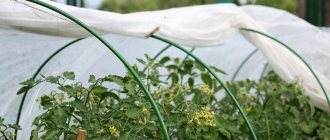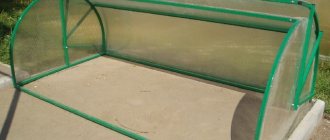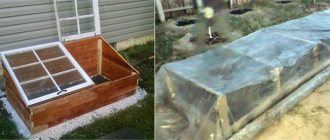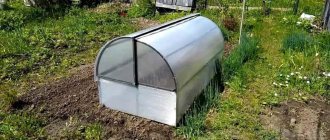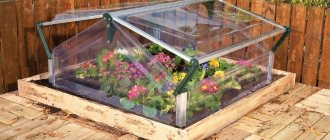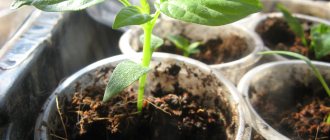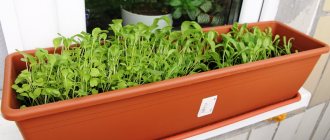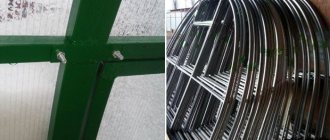Pros and cons of stretch film greenhouses
Stretch film is not a covering material for plants. However, when compared with polyethylene film or agrofibre, it has many advantages. Resourceful vegetable growers took this point into account and began using stretch film to cover greenhouses.
Advantages:
- In terms of price, covering greenhouses with stretch film is considered the most profitable;
- the service life of the material is 2-3 years;
- inside the greenhouse, the canvas retains heat and moisture;
- the stretch film holds well on the frame without requiring additional fasteners;
- the material does not lose its qualities during long-term storage.
To cover the greenhouse with stretch film, it is wrapped around the frame in several layers. The created air gap contributes to better heat retention. In terms of thermal insulation, the structure can be compared with a polycarbonate greenhouse, only the price is much lower.
Important! A multi-layer stretch film cover reduces the negative effects of sunlight on plants.
The elasticity of the fabric makes it easy to wrap frames of any complexity. The construction of a greenhouse occurs quickly without additional help.
Flaws:
- a multi-layer shelter accelerates the heating of the air inside the greenhouse, which in hot weather creates a danger to the plants;
- if there are no folding windows for ventilation, the period of use of the greenhouse is reduced to several months;
- constructing doors and vents is much more difficult than in a classic greenhouse;
- stretch film generates static electricity, which attracts dust, which causes rapid contamination.
After a couple of months, the new canvas becomes gray. The greenhouse loses its original appearance. Dust attracted by static electricity reduces light transmission. The greenhouse needs to be washed periodically, but it is difficult to do such a job.
Why cover the ends?
Cross sections of cellular polycarbonate sheets represent a series of open cells with thin walls. To give rigidity to the walls and protect them from damage, as well as to close the cells from moisture and dirt getting into them, special end profiles are provided.
Such profiles perform not only a protective, but also a decorative function, framing the cut out element with a neat, even edge. Therefore, they are used not only on transverse sections, but also on longitudinal ones, which do not need to be reinforced or sealed. They are also suitable for decorating products made of monolithic polycarbonate.
Open cells at the ends of polycarbonate Source amazonaws.com
In addition to profiles, special adhesive tapes are also used to protect cuts. Since there is a difference in how to cover the bottom of a polycarbonate greenhouse and its top, such tapes, unlike profiles, are available in two types - sealing and perforated.
To understand why these materials are needed at all, you need to look at what happens to cellular polycarbonate during operation.
- Dirt, dust, and small debris enter the empty channels through open holes and remain there forever, gradually sticking to the inner walls, reducing the transparency of the material and spoiling the appearance.
- Moisture also penetrates into them. At the ends facing upwards there is rain and snow, at the bottom there is dirty water from melting snow and irrigation.
- Wet, warm mud becomes a suitable environment for the proliferation of microorganisms, and over time the material becomes covered with mold.
- When freezing in winter, water accumulated in the canals can tear or deform their walls.
- Insects crawling into the channels cannot turn around and crawl back out, so they also remain in them.
- Any accidental blow or stone flying from under your foot easily damages the unprotected edge of the polycarbonate.
This is what a coating with unprotected ends will look like over time. Source wp.com
Therefore, when installing the material, it is so important to think about how to cover the ends of the polycarbonate, and how to do it correctly. One end profile is not capable of ensuring tightness, so special tapes are glued under it to perform this task. Moreover, different types are used depending on the position of the cross section of cellular polycarbonate.
If it is facing upward, use a sealing tape that does not allow either dust or water to pass through. The lower ends are covered with perforated strips so that the condensate formed in the honeycombs and flowing down can freely flow out. Such tapes allow only water to pass through, serving as a reliable barrier to insects and dirt.
But such tapes do not have sufficient rigidity to protect the edges from mechanical damage. This function is performed by the end profile, which completely hides the edges of the sheets treated with not very attractive tapes.
Combined protection from sealing tape and profile Source legkovmeste.ru
Options for greenhouses made of stretch film
There are few options for creating a greenhouse. It is easier to make a rectangular structure with a flat roof, but it will not last long. Accumulating precipitation will break through the fabric. A gable structure in the shape of a house can withstand heavy snow loads, but covering the roof with stretch film is difficult.
In order for a greenhouse made of stretch film to function in winter, it is optimal to choose an arc structure. The snow will easily slide off the roof slopes, which reduces the likelihood of the roof sheet breaking. The condensation formed inside will not drip onto the plants, but will flow smoothly down the arched shelter.
Preparation of greenhouse parts
In order to create a small do-it-yourself greenhouse, you need to prepare the following frame parts:
- bar 560 millimeters long - 4 pieces;
- bar 30 millimeters long - 4 pieces;
- bar 15 millimeters long - 4 pieces.
Details for making the roof:
- bar 490 millimeters long - 1 piece;
- 4 bars 250 millimeters long and with beveled ends at 45o.
The greenhouse is equipped with a hinged door on the roof, for which 2 planks 530 millimeters long and 2 planks 180 millimeters long are used.
Parts prepared to size must be carefully processed with sandpaper so that there are no burrs that could injure your hands.
An investigation by Samara local historians confirms: “Zoya’s Standing” is a legend
Juicy roll made from simple ingredients: potatoes, cheese and ham
Smart Clothing: Ingenious Tricks to Save Significant Time
Foundation for a greenhouse
When building a budget greenhouse made from small stretch film, you can do without a base. A timber foundation will be needed for a large building with a permanent wooden frame. If the skeleton of the greenhouse is made of metal, a base will be needed to securely fasten the posts. Usually the foundation is made of concrete or brick. Often the frame is assembled from polypropylene pipes. The racks can be securely fixed in compacted soil without a foundation.
Important! The higher and larger the greenhouse, the more wind load it is affected by. To ensure the stability of the greenhouse, the bottom trim is strengthened or the posts are deeper.
Important parameters
Wrapping with stretch film is an easy way to update your existing greenhouse. A ready-made frame made of any type of material will be suitable. However, special attention should be paid to the choice of film. If construction has to start from scratch, it is necessary to choose the type of structure, its dimensions, and even the type of foundation.
Base and materials
A foundation for such a greenhouse is not required. If the frame is heavy, for example, wooden, solid, then it is permissible to make a small base from timber or brick. In this way, rotting of the main supports can be prevented. If propylene tubes are used as a frame, you can get by with a standard seal of the selected area. If the walls are large and the height is more than one and a half meters, it is necessary to securely fasten the greenhouse frame to the ground. The film will not be elastic after stretching, so the wind will affect the entire area. If the soil allows, you can dig the supports deeply; a more reliable option is to strengthen them with a lower frame made of heavy materials.
When choosing stretch film, you should pay attention to the thickness, raw materials and barrier properties. You can compare several types according to the parameters indicated in the table:
| Film type | Thickness | Barrier properties |
| Kling film | from 5 to 11 µm | low, easy to tear |
| PVC | from 20 to 30 microns | medium, breaks with effort, but allows heat to pass through |
| EVA | from 13 to 20 microns | high, has better thermal insulation properties |
| polystyrene | from 7 to 18 µm | medium, breaks with effort, but has less elasticity |
The best option for a greenhouse would be films made of PVC or polypropylene. Kling materials are too thin; at least 5-7 layers are required for sufficient insulation, but light transmission in this case drops sharply. Polystyrene compounds are too inelastic; EVA films have better mechanical characteristics, but their cost is several times higher, so it is not recommended to use them for homemade greenhouses.
In Europe, PVC products are not used because they are considered toxic. But in some countries there is no such ban.
When working with film, it is necessary to take into account its type in order to avoid common mistakes. Polystyrene products have little stretch, while PVC compositions can extend 3-4 times. The recommended stretching rate is no more than three times. Thus, it is possible to maintain firmness, elasticity, strength and achieve a strong connection between layers of material. Thermal welding is not used: under the influence of temperature, stretch materials melt and shrink, and no fixing occurs. It is also unacceptable to pierce metal fasteners in free areas where there is no strong support around the perimeter. Any adhesives must be used carefully. Some chemical elements can literally “eat away” the film.
Design
An arc-shaped design is considered optimal. It can be assembled from vertical supports and film; nothing else is required. At the same time, you can achieve almost any height by choosing a frame of the required thickness. This form does not require the construction of a base or roof; if necessary, each individual element can be replaced.
When choosing the shape of a future greenhouse, it is necessary to take into account the level of snow load and the possible impact of condensation. If the heifer is year-round, stingrays are required. It is extremely difficult to construct a gable roof from film; the arc shape, in turn, will not allow snow to accumulate on top of the structure, so collapse is unlikely. Inside, condensation will flow down the walls, which is also desirable. The soil will thus be moistened and no drops will fall on the leaves.
Greenhouse frame material
The stability and service life of the greenhouse depend on the strength of the frame. To create the structure, the following materials are most often used:
- Wood is considered a classic material for greenhouses. The wood is cheap and easy to process. The disadvantage is the susceptibility to rotting in damp conditions.
- Metal is stronger than wood and will last longer, but is susceptible to corrosion in damp conditions. For a greenhouse, it is optimal to use galvanized metal pipes or profiles.
- Aluminum is considered the best material. The frame of the greenhouse is durable, lightweight, and will last for many years. The disadvantage is the high cost.
Recently, greenhouses have often been built from stretch film on a plastic frame. The material is water pipes. The blanks are connected with original fittings. The frame is lightweight and resistant to the humid microclimate of the greenhouse.
What do you need to prepare for work?
To build a greenhouse you will need the following:
- wooden blocks with a cross section of 50 x 50 millimeters;
- wooden board 25 x 50 millimeters;
- a roll of transparent packaging tape;
- self-tapping screws;
- universal wood glue;
- scissors;
- electric drill;
- sandpaper;
- roulette;
- square with an angle of 45°;
- hacksaw;
- pencil or pen;
- clamps;
- 2 furniture hinges with fasteners for them;
- screwdriver;
- protective coating for wood;
- brush.
Which stretch film to choose for a greenhouse
There are several types of stretch film. The service life of the greenhouse cover depends on parameters such as thickness and resistance to external factors. The table will help you choose the right stretch film.
To cover the greenhouse with stretch film at home, it is optimal to choose PVC fabric. Kling film is thin. It will have to be wound up to seven layers. The insulation is better, but the light transmittance is reduced. Polystyrene stretch film has a weak elasticity indicator. EVA fabric is considered ideal in all respects. However, the high cost of stretch film does not make it popular for home greenhouses.
Important! PVC film is not used for greenhouses in European countries, as it is considered toxic. However, there is no ban on the territory of the post-Soviet space.
Stretch film, which has a maximum tensile strength of three times, is optimal for covering greenhouses. PVC fabric has a suitable parameter. Due to the elasticity and elasticity of PVC stretch film, it creates a strong adhesion of all layers of the shelter.
To join the film, you cannot use thermal welding, piercing fasteners, or adhesives on aggressive bases. Each element can damage the canvas and break the tightness of the greenhouse.
Edge tapes
Self-adhesive edge tapes for the ends of cellular polycarbonate differ from adhesive tape and similar products in that they are permeable to air. This feature allows air to circulate quite freely in the honeycombs, which is important for structures such as greenhouses.
The tape covering the upper ends of the open channels completely protects them from moisture, debris, and insects. It comes in different lengths and widths. There is always information on the packaging about the thickness of the polycarbonate sheet such protection is intended for. The adhesive layer on the sides of the tape is covered with film or paper, which is removed during installation.
Sealing tape for polycarbonate 4-6 mm thick Source sdelai-lestnicu.ru
How to build and wrap a greenhouse with stretch film
The construction of a greenhouse begins with calculations. Dimensions are determined taking into account the number and type of crops grown. For example, for bush plants, you can make a greenhouse from stretch film with a height of one and a half times the maximum growth of the crop. A height of 80 cm is sufficient for cucumbers. However, low greenhouses are difficult to maintain. The normal height is 1.5-1.7 m.
The length is taken arbitrarily, and the width is calculated taking into account the number of beds. Usually it is done alone. The greenhouse is given a width of 1 m. If there are two beds, then the width of the building is doubled, in addition, 30 cm is added to the path. It is easier to build two narrow greenhouses standing next to each other, designed for one bed. A path is left between the structures to clear the snow and wash the stretch film shelter.
The calculation of the frame begins with determining the number of arcuate supports. The indicator depends on the length of the structure. If the supports are strong and low, the wind load on the greenhouse is weak, they are placed at a distance of 2.5 m. With an increase in the wind load and dimensions of the structure, the pitch of the supports is reduced to 1.5 m. If there is no foundation, each support is buried at least 50 cm into the ground.
The consumption of stretch film depends on its quality and the dimensions of the frame. PVC fabric is usually stretched in two layers. The edges overlap 1/3 of the width of the strip. To calculate the required amount of canvas, measure the perimeter of the greenhouse frame. 1/3 is added to the indicator and multiplied by 2. The finished result is increased by another 10%. The reserve is needed for the formation of a “skirt” near the ground. The hanging edge will protect from the wind. It is important to remember that stretch film stretches. To avoid a large remainder, the resulting calculation result is divided by 2.
In the video, a greenhouse for pennies made of stretch film:
The assembly of the structure begins with the installation of the frame. Light arcs made of plastic pipes are simply buried in compacted soil or put on driven-in reinforcement pins. If a wooden base is required, it is assembled in the form of a rectangular frame made of timber. The joints are reinforced with mounting corners. Arc-shaped supports are attached to the side of the frame with clamps and self-tapping screws.
The assembly of a wooden or metal frame is carried out in a different sequence. The end sides of the greenhouse are created first. The second stage involves assembling the lower trim, installing supports, and finishing with the top trim.
The final step is to cover the greenhouse with stretch film, and work begins from the top. The first to lay a horizontal turn under the supports to fix the canvas. The first layer of film does not overlap. The lanes overlap when moving backwards from top to bottom.
The door and vents for ventilation are difficult to manufacture. In the selected area, the stretch film is stapled to the frame, if it is wooden. The sheet is secured to plastic pipes with clamps. Door and window leaves are made from glazing beads. The film is stapled to the frame in the area attached to the frame of the greenhouse. The edge of a knife is used to cut openings.
Instructions for gluing TPL tape
The excellent adhesive properties of the adhesive used on the surface of the tape provide the ability to successfully repair both the film covering of the greenhouse and polycarbonate sheets or glass.
Repair tape should be used in the following order:
- Preliminary surface preparation. Mechanical cleaning of contaminants is carried out. Next, the surface is treated with an alcohol solution with a concentration of over 70%. Under no circumstances should other compounds be used for degreasing.
- It is necessary to place a rigid base under the damage site - a sheet of plywood or something similar.
- Apply tape to the surface, bringing the edges of the tear together, press tightly, iron.
- Repeat the steps on the inside.
With these instructions you can easily repair your greenhouse or greenhouse.
Common mistakes and recommendations
It is often impossible to create a greenhouse from stretch film using video and photos with your own hands without making mistakes. The main problem is considered to be the poor quality of the frame. The canvas is held in place by tension. If the frame is shaky and has jagged edges, the shelter will sag and begin to tear.
Saving on the number of layers is unacceptable. This will affect the thermal insulation properties. Winding in one layer quickly spreads and does not preserve the greenhouse microclimate.
With an increase in the windage of the greenhouse, enhanced fastening of the shelter is required. The film is additionally fixed with slats diagonally at a height of 1.5 m. A ridge girder made of slats is laid at the top through all arc supports.
Some subtleties you should know
The problem that amateur gardeners face when attaching the film to the frame is that the metal, due to its rigid structure, deforms the softer material, rendering it unusable. A simple way to solve the problem is to glue the contact area between the frame and the covering material with construction tape.
By the way, this procedure will prevent the film from another problem - heating. Metal covered with white construction tape will heat up less, which means the impact of high temperatures on the coating will be minimal.
